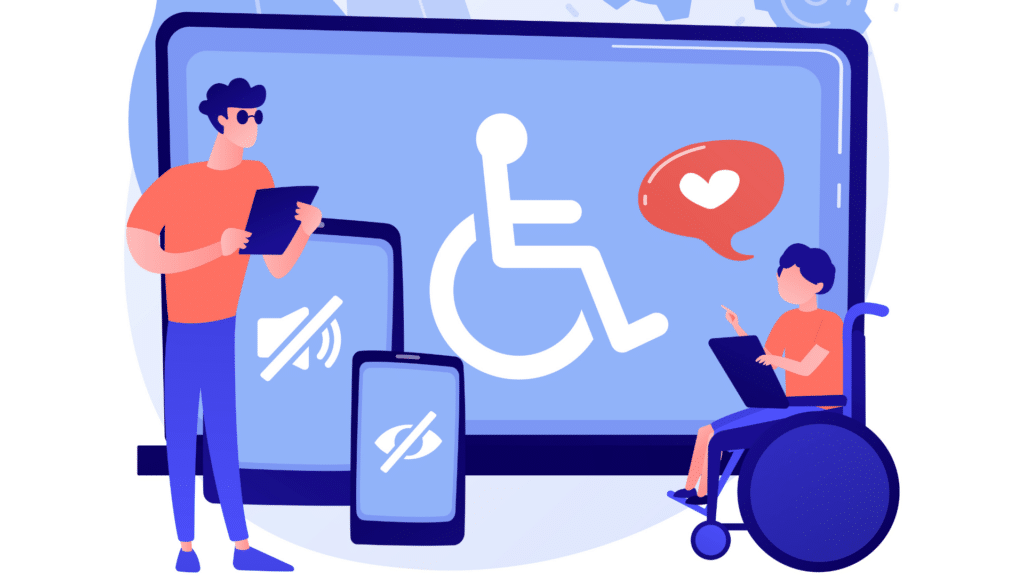
The importance of accessibility in digital communication: How companies can create inclusive content
Marketing
Posted 10 Oct 2024
For some time now, accessibility has no longer just been an optional extra but has become an indispensable foundation of any successful communication strategy. It is not just a matter of fulfilling legal requirements — rather, the focus of such efforts is to provide access to digital content for all people, regardless of their abilities or limitations. This is not only an ethical obligation, but also a smart business decision. This aspect can be particularly important for companies, as inclusive digital communication not only strengthens the brand image but can also open up new target groups. But what exactly does accessibility mean in digital communication, and how can companies ensure that their content is truly inclusive? So, it’s high time to take a closer look at this topic!
Digital accessibility means that websites, apps, and other digital products are designed in such a way that they can be used by everyone, including people with disabilities. This includes a variety of measures, such as:
– Screen reader compatibility: content must be designed in a format that it can be captured and read aloud by screen readers.
– Alternative text for images: Images should have alternative text describing the content of the image, as well as the different colors.
– Easy navigation: Websites and apps should be easy to navigate, even without a mouse, for example, using keyboard commands.
– High-contrast colors: Color contrasts should be chosen so that text is easy to read, even for people with visual impairments.
– Subtitles and transcripts: Videos should be subtitled, and audio content should be transcribed to make it accessible for deaf people.
– Linguistic relevance: To address the linguistic plurality in the society the language of the content should be adapted to the needs of the society, additional languages can be adjusted providing translations in the subtitles
The importance of accessibility goes far beyond social responsibility. Here are some reasons why companies should prioritize accessible digital communications:
– Reach and audiences: accessible content allows companies to reach a wider audience. People with disabilities make up a significant portion of the population and are often overlooked or neglected.
– Search engine optimization (SEO): accessible websites are also typically more accessible to search engines, which can lead to better rankings in search results.
– Brand image and reputation: Companies that strive for inclusion improve their brand image and gain the trust and loyalty of their customers.
– Legal requirements: In many countries, there are legal requirements for digital accessibility. Companies that do not comply with these risks face legal consequences and penalties. By 2025, however, all EU countries should have implemented accessibility within their national legislation — accordingly, it will then become mandatory throughout the EU.
a) Planning and awareness
The first step towards accessible content is to create awareness of the need for this within the company. This can be followed by planning concrete steps: trainings and workshops can help to promote the understanding and implementation of accessibility in the day-to-day business affairs.
b) Web design and development
A key aspect of creating accessible digital content in today’s era is web design and development. Accessible templates can be a great help here. These design templates are already designed to meet many accessibility requirements and provide a solid foundation for an optimal result. Using such templates makes it easier for companies to design accessible digital offerings from the outset.
Regular testing of the website’s accessibility is also essential. Tools such as WAVE or Axe offer an excellent opportunity to identify potential weaknesses. Furthermore, obtaining feedback from people with disabilities is essential. This is the only way for companies to ensure that their offerings are truly inclusive and continuously improving.
c) Content and media
Accessibility is not just limited to technical implementation; important aspects must also be considered when creating content and media. A central point is the use of alternative texts. Every image on a website should be provided with a descriptive alternative text to make the content of the image accessible to visually impaired people.
In addition, it is significant to always provide videos with subtitles. This ensures that deaf people also receive all the information. In addition to these measures, a clear structure of the content also contributes to accessibility. Headings, paragraphs, and lists should be clear and organized in the best possible way to improve comprehensibility and make it easier for users to navigate through the content.
d) Continuous improvement
With continuously changing technologies and standards companies must adapt to these changes. Regular reviews and updates of content are therefore vital to ensure that it meets current requirements.
Companies that take the importance of accessibility seriously and regularly work on optimizing their digital offerings make an important contribution to greater inclusion. This not only strengthens their reputation, but also enables them to reach a larger target group.
Digital accessibility is not a one-off project, but an ongoing process that requires continuous attention and adjustments. For companies, creating accessible content is not only an opportunity to meet legal requirements and improve their brand image, but more importantly an opportunity to promote a more inclusive society. By putting accessibility at the heart of their digital communications, companies can reach a broad and diverse audience and achieve sustainable success.
With these measures, companies can make a decisive contribution to inclusion and strengthen their competitiveness at the same time. Accessibility is not just an obligation, but an opportunity for innovation and growth in digital communication.

Junior Communication Consultant at HBI Communication Helga Bailey GmbH
Annika Müller has been supporting HBI in the areas of PR and marketing since 2022. As a Junior Communication Consultant, her responsibilities include the creation of professional articles & the conceptualization of social media postings.
Furthermore, Annika is involved in directly assisting our client work.